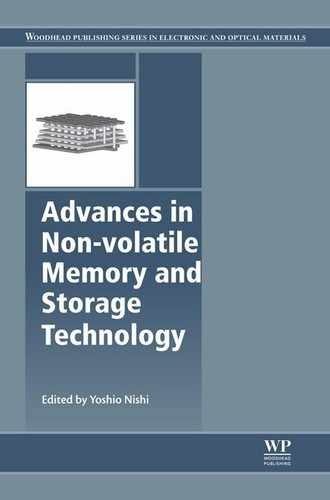Table of Contents
Woodhead Publishing Series in Electronic and Optical Materials
1. Overview of non-volatile memory technology: markets, technologies and trends
1.2 The non-volatile memory (NVM) market and applications
1.3 Developments in charge storage memory technology
1.4 Alternative memory storage concepts
1.5 Beyond evolutionary architecture scaling
Part I: Improvements in Flash technologies
2. Developments in 3D-NAND Flash technology
2.2 2D-NAND Flash memory: limitations in scaling
2.3 3D-NAND Flash memory with vertical channels
2.4 3D-NAND Flash memory with horizontal channels
2.5 Performance and electrical characteristics of different 3D-NAND Flash memory designs
3. Multi-bit NAND Flash memories for ultra high density storage devices
3.4 Program and erase algorithms
3.5 Reliability issues in NAND Flash memory technologies
3.7 Conclusion and future trends
4.5 Split-gate charge trap memories
Part II: Phase change memory (PCM) and resistive random access memory (RRAM) technologies
5. Phase change memory (PCM) materials and devices
5.2 Phase change materials: structure and crystallization kinetics
5.3 Properties of phase change materials
5.4 Phase change memory (PCM): principles and modeling
5.5 PCM device design and engineering
5.6 Conclusion and future trends
6.2 Strategies for improving the PCM performance
6.4 Fabrication of phase change nanowires (PC-NWs): top-down approaches
6.5 Fabrication of phase change nanowires (PC-NWs): bottom-up approaches
6.6 Fabrication of phase change nanowires (PC-NWs): other techniques
6.7 Characterization of PC-NWs
6.9 Sources of further information and advice
7. Nanowire phase change memory (PCM) technologies: properties and performance
7.2 Melting temperature and crystallization kinetics
7.3 Phase transition mechanisms
7.6 Properties of core-shell structures
7.9 Sources of further information and advice
8. Modeling of resistive random access memory (RRAM) switching mechanisms and memory structures
8.2 Methodology for ab initio modeling of OxRRAMs
8.4 OxRRAM optimization based on DFT-based ab initio modeling
8.5 Conclusion and future trends
9. Metal oxide resistive random access memory (RRAM) technology
9.2 Operational characteristics of HfO2-based RRAM
9.3 Modeling forming and switching processes
9.4 Materials development: engineering vacancy profiles for RRAM
9.5 Read current instability (random telegraph noise)
10. Conductive bridge random access memory (CBRAM) technology
10.2 Scaling challenges in dynamic random access memory (DRAM)
10.3 Scaling challenges in Flash memory
10.4 Marketplace challenges for emerging memory technologies
10.5 Operation of a CBRAM cell from an atomic wire point of view
10.6 The ON state of a CBRAM cell and the programming operation
10.7 The OFF state of a CBRAM cell and the erase operation
10.8 Conclusion and future trends
11. Memristors for non-volatile memory and other applications
11.2 The realization of memristor devices
11.3 Design of memristor-based non-volatile memory
11.4 Other promising memristor applications
11.7 Appendix: Memristor characteristic properties
Part III: Alternative emerging technologies
12. Molecular, polymer and hybrid organic memory devices (OMDs)
12.2 Types of organic memory devices (OMDs)
12.3 Conclusion and future trends
13. Nano-electromechanical random access memory (RAM) devices
13.2 Device structure and cell operation
13.3 Fabrication process for a prototype cell
13.4 Assessing cell reliability
14. Ferroelectric random access memory (FRAM) devices
14.2 Basic properties of ferroelectric capacitors
14.3 Ferroelectric materials used for FRAM devices
14.4 FRAM fabrication processes
14.5 Ferroelectric memory cell structure of capacitor-type FRAM devices
14.6 Assessing the reliability of FRAM devices
14.7 Applications of FRAM devices
14.8 Conclusion and future trends
15. Spin-transfer-torque magnetoresistive random access memory (STT-MRAM) technology
15.4 Improving logic-in-memory architecture
